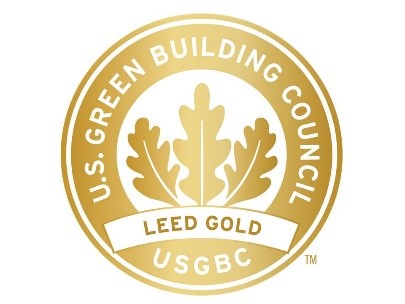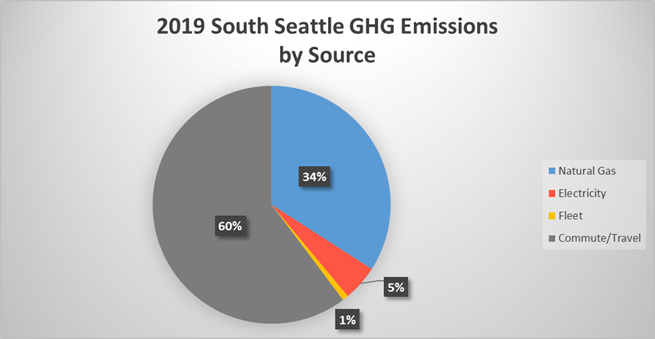Sustainable Operations
- Buildings
- Food & Agriculture
- Grounds
- Sustainable Materials Management
- Transportation
- Water & Air
- Sustainability Goals & Initiatives
Buildings
LEED
Since 2005, all Washington State owned buildings must be built to LEED Silver or better. LEED stands for Leadership in Energy and Environmental Design and is overseen by the United States Green Building Council (USGBC), a membership based non-profit organization that promotes sustainability in building design, construction, and operation.
University Center (Completed in 2005)
- Reused brownfield site to reduce impact of new building (reuse of existing building site)
- No new parking was added
- Natural “bioswale” was created to better manage storm water
- Drought-tolerant plantings were used to reduce irrigation water
- Operable windows and sunshades were installed to reduce energy usage
- Rapidly renewable and recycled materials were used in construction, including in the carpet and wall board
Cascade Hall 
Cascade Hall, designed by McGranahan Architects and built by Korsmo Construction, earned LEED Gold in spring 2018. Located on South Seattle’s main campus, it consists of 58,000 square feet of classroom and lab space serving 140 students. The total project cost was $32M, or about $552/square foot. In addition to being built to meet the strict 2012 Seattle Building Code, Cascade Hall has the following sustainability features:
Energy
- Site layout and window glazing maximizes natural daylighting, reducing lighting needs and improving occupant comfort, productivity, and health.
- Controlled lighting and power receptacles to reduce electricity usage
- 100% LED interior and exterior lighting
- Small 72kW Photovoltaic (PV) system on the roof
- Occupancy sensors and daylight sensors reduce electricity use automatically
- Finned tube convectors at glazing help offset exterior glazing heat losses, reducing natural gas usage in colder months
- High efficiency natural gas units
- Reduced energy consumption costs by 36% compared to baseline buildings
Materials
- Local/regional, recycled content (23%), and green certified materials incorporated into various parts of the building
- Steel, brick, wood, and concrete building materials were selected for their durability, cost effectiveness, low maintenance, and other general sustainability characteristics to reduce long-term environmental and economic impacts
- Diverted more than 95% of construction and demolition waste from the landfill during construction
- Low-emitting materials improve indoor air quality (IAQ)
Water/Site
- 40,000 cubic foot storm detention pipe system reduces storm water surges into a vulnerable municipal system
- Low flow toilets and other water efficiency technology
- Rain gardens were incorporated into landscaping- treating and reducing stormwater on site
- Native and drought resistant plants were incorporated into landscaping to reduce the need for irrigation
- Green roof assemblies:
- Reduce heat island effect- reducing electricity for cooling and natural gas for heating (acts as additional insulation)
- Capture rain water and reduce storm water runoff, and beautiful views of Mt. Rainier on a clear day are also included
Food & Agriculture
Food Pantry
South Seattle students, staff, and faculty opened an on-campus food pantry circa April 2017 to help provide essential food and toiletry items to students in need. The food pantry promotes the academic success of students living at or near the poverty line and dealing with housing and food insecurity by providing a reliable source of food on-campus. Many students may not have access to community food banks during class times or face shortages from supplemental food programs. The pantry is funded partially by Student Services and Activity Fees, along with community sponsors, and is supported by the United Student Association and Phi Theta Kappa.
Grounds
Arboretum
The arboretum was established by the College and the South Seattle College Foundation in 1978, in part as the result of a petition by the Landscape Horticulture (LHO) program students for an arboretum to serve as their living laboratory. The 6-acre site is located at the north end of campus on a bluff over-looking downtown Seattle, Elliot Bay, and the West Duwamish Greenbelt. The Seattle Chinese Garden borders the Arboretum.
The Arboretum is an important part of the South Seattle College LHO program. As part of their studies, students designed and built the arboretum. It is used as a laboratory for courses in plant identification, arboriculture, pruning, irrigation, garden renovation, plant problem diagnostics, landscape management and landscape construction courses. The Arboretum is also used as an outdoor classroom by professional horticulturists, hobby gardeners, and other college programs. Most of the plants on the Washington Certified Professional Horticulturist exam can be found in the South Seattle Arboretum.The South Seattle College Arboretum was established by the College and South Seattle Foundation in 1978, in part as the result of a petition by the Landscape Horticulture Program students for an arboretum to serve as their living laboratory. The 5-acre site is located at the north end of campus on a bluff over looking the downtown Seattle, Elliot Bay, and the West Duwamish Greenbelt.
The Arboretum is an important part of the South Seattle Landscape Horticulture Program. As part of their studies, students designed and built the Arboretum. It is used as a laboratory for courses in plant identification, arboriculture, pruning, irrigation, garden renovation, plant problem diagnostics, landscape management and landscape construction courses. The Arboretum has been “pesticide-free” since 2008.
Seattle Chinese Garden
Under the guidance of the Seattle City Council and Seattle's Department of Parks and Recreation, the Seattle Chinese Garden Society was founded to coordinate the development of this garden. The Chinese Garden is located at the north end of main campus, near the arboretum, on a bluff over-looking downtown Seattle, Elliot Bay, and the West Duwamish Greenbelt. It provides visitors a tranquil space to write, think, meditate, talk, etc.
The Song Mei Pavilion, designed and fabricated in Seattle's sister city, Chongqing, China, and assembled here by a team of Chinese artisans, is the first of many planned structures in the six-acre garden. Visit the web site of the Seattle Chinese Garden Society to learn more about the history of the garden and its design.
Additional Areas:
- College crews converted two of the diesel-power mowers to use B-99 bio-diesel, which is 99 percent bio-fuel, rather than the 30 percent of some conversions
- A bio-diesel fuel tank was installed on campus to eliminate trips to purchase fuel off campus
- The campus has converted some gasoline-powered carts to plug-in electric vehicles
Sustainable Materials Management
- Composting: South Seattle offers composting in most dining areas — keeping food and compostables out of the garbage stream. Food and compostables that biodegrade in landfills emit harmful greenhouse gas (GHG) emissions and garbage hauling fees are more than compost.
- Compostable disposables: South's dining areas have nearly converted all disposable service-ware to compostables
- Signage: the Sustainability Committee has been replacing and installing signage where none existed. The Committee partnered with Seattle Public Utilities to create customized signage for Seattle Colleges that better represents materials found on campus. The Committee also created 3D signage for the dining area so individuals can match what is on their tray/in their hand, with the correct compost, recycling, or garbage receptacle.
- Waste Audits: South Seattle College students, faculty, and staff have conducted waste audits annually the past few years. Waste audits provide participates education on what is compostable and recyclable, while also providing valuable data and insight into disposal behavior. The Sustainability Committee has used this data and information to create custom signage and outreach campaigns to improve sorting.
Transportation
- Commute Trip Reduction Program (PDF)
- The college encourages reduced automobile use through van service, subsidized bus passes, rewards for carpooling, and fees for parking. For more information, please visit Transportation Information page.
- Electric Vehicle (EV) charging stations: In 2018, South Seattle College installed 2 DC Fast Chargers (one on main campus and one at Georgetown) and 4 Level 2 Chargers (2 on main campus and 2 at Georgetown).
Water & Air
- The newest buildings on campus have low-flow/low-use plumbing fixtures in restrooms.
- Older buildings have been retrofitted with improved plumbing fixtures.
- Exterior watering has been reduced and limited to a small part of the campus.
Sustainability Goals & Initiatives
Greenhouse Gas Goals (2005 baseline)
As a state agency, Seattle Colleges, which South Seattle College is a part of, is required to report annual greenhouse gas emissions from Scope 1 and 2 sources (i.e. utility and fleet energy) in compliance with the State Agency Climate Leadership Act. This act, passed in 2008, established greenhouse gas baseline date and greenhouse gas reduction targets for all state agencies. In partnership with the Department of Ecology, Seattle Colleges has set a baseline of greenhouse gas emissions (2005- 3,995 MTCO2e), as well as emission reduction targets in 2020, 2030, 2040, and 2050. In 2020, WA State passed HB 2311, which amended “state greenhouse gas emission limits for consistency with the most recent assessment of climate change science.”
| Year | Original Target | New Target | Seattle Colleges MTCO2e |
| 2020 | 20% | 15% | 3,396 |
| 2030 | N/A | 45% | 2,197 |
| 2035 | 36% | N/A | N/A |
| 2040 | N/A | 70% | 1,199 |
| 2050 | 57.5% | 95% | 200 |
While South Seattle College does not have campus-level mandates, we still track GHGs at the campus level and have charted them according to state targets.

